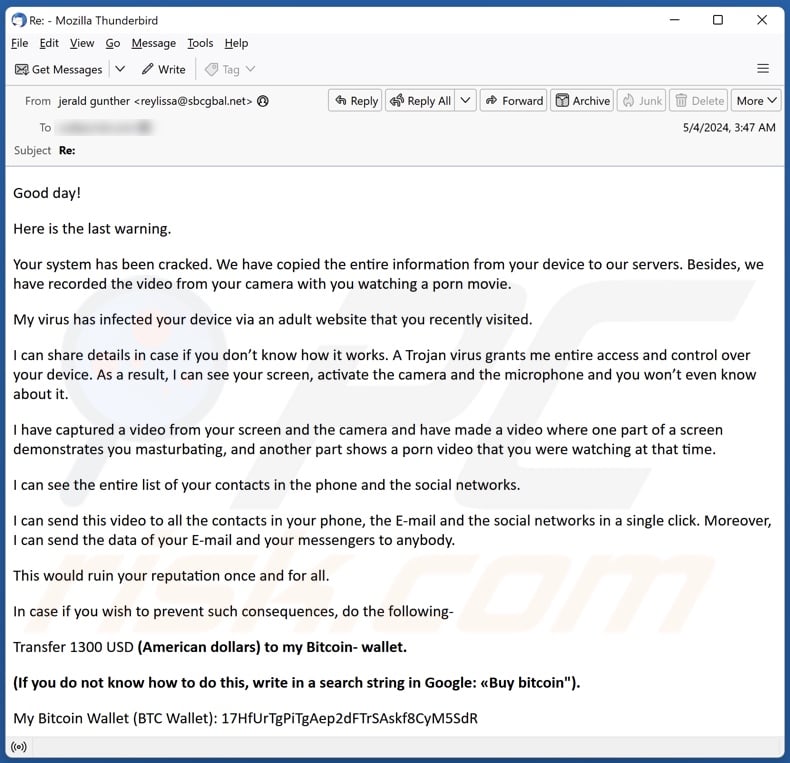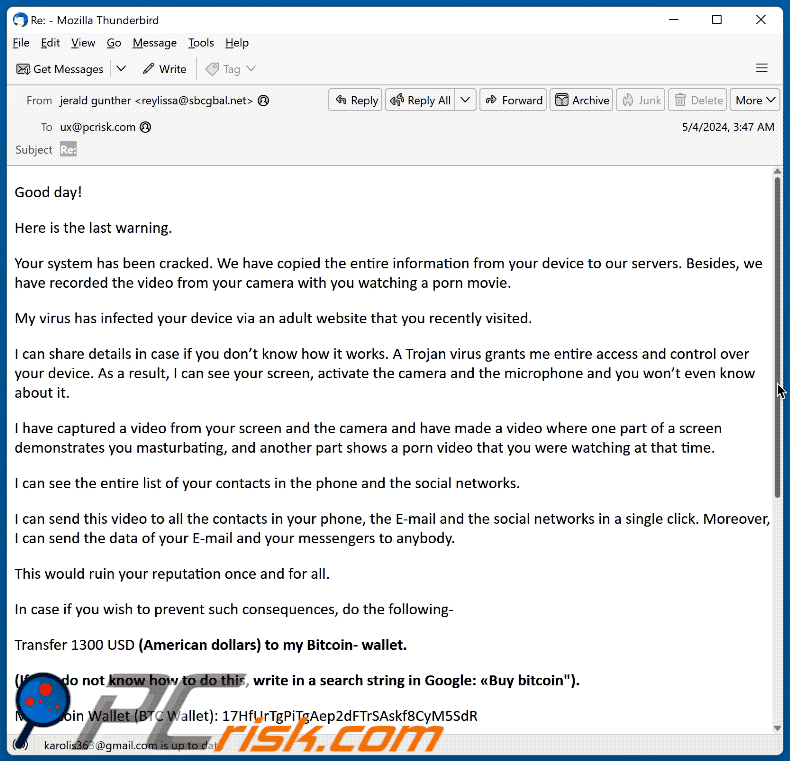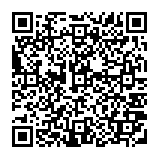Avoid getting scammed by fake "Your System Has Been Cracked" emails
![]() Written by Tomas Meskauskas on
Written by Tomas Meskauskas on
What kind of email is "Your System Has Been Cracked"?
After reading the "Your System Has Been Cracked" email, we determined that it is spam promoting a sextortion scam. This letter falsely claims that the recipient's device was hacked by the sender and used to record a compromising video. The recording will be sent to the recipient's contact lists if they do not comply with the ransom demands.
It must be stressed that the information provided by "Your System Has Been Cracked" is fake. Hence, this email poses no threat to recipients.

"Your System Has Been Cracked" email scam overview
This spam email states that the recipient's device was breached, and all its information was copied to the supposed attackers' servers. The breach was facilitated by a trojan virus that allowed the sender access to the compromised machine. The recipient infected their device by visiting an untrustworthy adult-oriented website.
This nonexistent malware was then used to hijack the device's camera/microphone and record a sexually explicit video of the recipient while they were watching pornographic content. The recording was edited into a video showing them and the content they were viewing at the time.
The recipient is given 50 hours to transfer 1300 USD in Bitcoin cryptocurrency to the provided cryptowallet address. If they refuse to comply, the imaginary video will be sent to their phone, email, and social media contacts. The footage will also be leaked if this spam letter is shared with anybody.
As mentioned in the introduction, all the claims made by "Your System Has Been Cracked" are false. Therefore, neither was the recipient's device infected nor has the sender made any recordings of them.
Trusting this hoax email results in financial loss. Additionally, due to the practically untraceable nature of cryptocurrency transactions – they cannot be reversed. Hence, victims of such sextortion scam emails cannot get their money back.
| Name | "Your System Has Been Cracked" sextortion scam |
| Threat Type | Phishing, Scam, Social Engineering, Fraud, Sextortion Scam |
| Fake Claim | Explicit recordings were made of the recipient and will be sent to their contacts unless they pay a ransom. |
| Cyber Criminal Cryptowallet Address | 17HfUrTgPiTgAep2dFTrSAskf8CyM5SdR (Bitcoin) |
| Distribution methods | Deceptive emails, rogue online pop-up ads, search engine poisoning techniques, misspelled domains. |
| Damage | Monetary loss |
| Malware Removal (Windows) | To eliminate possible malware infections, scan your computer with legitimate antivirus software. Our security researchers recommend using Combo Cleaner. |
Sextortion spam campaign examples
We have written about numerous spam campaigns; "Internet Is A Dangerous Place", "You Have Been Under Surveillance", "News That's Not Very Cheerful", and "You Are Now On The Radar Of An International Group Of Hackers" are just some of our newest articles on sextortion scam emails.
Various schemes are promoted through spam mail, including (but not limited to) phishing, tech support, refund, lottery, inheritance, etc. Deceptive emails are also used in malware distribution.
While the commonly held belief that spam letters are poorly constructed and riddled with errors is not untrue, it is not always the case. These emails can be competently crafted and even believably disguised as messages from legitimate entities (e.g., companies, service providers, institutions, authorities, etc.).
How do spam campaigns infect computers?
Cyber criminals often use spam campaigns to proliferate malware. Scam emails can have infectious files attached to or linked inside them. The files come in various formats, e.g., documents (Microsoft Office, Microsoft OneNote, PDF, etc.), executables (.exe, .run, etc.), archives (ZIP, RAR, etc.), JavaScript, and so on.
Once a malicious file is opened – the infection chain is initiated. Some formats can require additional user interaction to jumpstart these processes. For example, Microsoft Office files need users to enable macro commands (i.e., editing/content), while OneNote documents require them to click on embedded links or files.
How to avoid installation of malware?
It is essential to exercise caution with incoming emails, DMs/PMs, SMSes, and other messages. We advise against opening attachments or links present in suspicious/irrelevant mail, as they can be harmful or virulent.
It must be mentioned that malware is not spread exclusively via spam mail. Therefore, it is crucial to be vigilant while browsing, as fraudulent and malicious online content usually appears legitimate and harmless.
Additionally, all downloads must be performed from official and verified channels. Another recommendation is to activate and update software using functions/tools provided by genuine developers, as illegal activation tools ("cracks") and third-party updates can contain malware.
We must emphasize the importance of having a reputable anti-virus installed and kept updated. Security programs must be used to run regular system scans and to remove threats and issues. If you've already opened malicious attachments, we recommend running a scan with Combo Cleaner Antivirus for Windows to automatically eliminate infiltrated malware.
Text presented in the "Your System Has Been Cracked" spam email letter:
Subject: Re:
Good day!
Here is the last warning.
Your system has been cracked. We have copied the entire information from your device to our servers. Besides, we have recorded the video from your camera with you watching a porn movie.
My virus has infected your device via an adult website that you recently visited.
I can share details in case if you don’t know how it works. A Trojan virus grants me entire access and control over your device. As a result, I can see your screen, activate the camera and the microphone and you won’t even know about it.
I have captured a video from your screen and the camera and have made a video where one part of a screen demonstrates you masturbating, and another part shows a porn video that you were watching at that time.
I can see the entire list of your contacts in the phone and the social networks.
I can send this video to all the contacts in your phone, the E-mail and the social networks in a single click. Moreover, I can send the data of your E-mail and your messengers to anybody.
This would ruin your reputation once and for all.
In case if you wish to prevent such consequences, do the following-
Transfer 1300 USD (American dollars) to my Bitcoin- wallet.
(If you do not know how to do this, write in a search string in Google: «Buy bitcoin").
My Bitcoin Wallet (BTC Wallet): 17HfUrTgPiTgAep2dFTrSAskf8CyM5SdR
Immediately after crediting of payment I shall erase your video and shall not bother you anymore.
You have 50 hours (a little more than 2 days) to make the payment.
I receive an automatic notification of reading of this letter. The timer will also automatically launch right after you read this E-mail.
Don’t try to complain anywhere- my BTC –wallet cannot be traced and an E-mail that sent you the letter is created automatically-any response would be senseless.
Should you try to share this E-mail with somebody, the system will automatically send a request to the servers and they will start sending the entire information to social networks.
The change of passwords of social networks, an E-mail and the device would be senseless either as the whole data has already been downloaded to cluster of my servers.
I wish you luck and don’t do something stupid. Consider your reputation.
Appearance of the "Your System Has Been Cracked" spam email (GIF):

Instant automatic malware removal:
Manual threat removal might be a lengthy and complicated process that requires advanced IT skills. Combo Cleaner is a professional automatic malware removal tool that is recommended to get rid of malware. Download it by clicking the button below:
▼ DOWNLOAD Combo Cleaner
By downloading any software listed on this website you agree to our Privacy Policy and Terms of Use. To use full-featured product, you have to purchase a license for Combo Cleaner. 7 days free trial available. Combo Cleaner is owned and operated by Rcs Lt, the parent company of PCRisk.com read more.
Quick menu:
- What is "Your System Has Been Cracked" sextortion scam?
- Types of malicious emails.
- How to spot a malicious email?
- What to do if you fell for an email scam?
Types of malicious emails:
![]() Phishing Emails
Phishing Emails
Most commonly, cybercriminals use deceptive emails to trick Internet users into giving away their sensitive private information, for example, login information for various online services, email accounts, or online banking information.
Such attacks are called phishing. In a phishing attack, cybercriminals usually send an email message with some popular service logo (for example, Microsoft, DHL, Amazon, Netflix), create urgency (wrong shipping address, expired password, etc.), and place a link which they hope their potential victims will click on.
After clicking the link presented in such email message, victims are redirected to a fake website that looks identical or extremely similar to the original one. Victims are then asked to enter their password, credit card details, or some other information that gets stolen by cybercriminals.
![]() Emails with Malicious Attachments
Emails with Malicious Attachments
Another popular attack vector is email spam with malicious attachments that infect users' computers with malware. Malicious attachments usually carry trojans that are capable of stealing passwords, banking information, and other sensitive information.
In such attacks, cybercriminals' main goal is to trick their potential victims into opening an infected email attachment. To achieve this goal, email messages usually talk about recently received invoices, faxes, or voice messages.
If a potential victim falls for the lure and opens the attachment, their computers get infected, and cybercriminals can collect a lot of sensitive information.
While it's a more complicated method to steal personal information (spam filters and antivirus programs usually detect such attempts), if successful, cybercriminals can get a much wider array of data and can collect information for a long period of time.
![]() Sextortion Emails
Sextortion Emails
This is a type of phishing. In this case, users receive an email claiming that a cybercriminal could access the webcam of the potential victim and has a video recording of one's masturbation.
To get rid of the video, victims are asked to pay a ransom (usually using Bitcoin or another cryptocurrency). Nevertheless, all of these claims are false - users who receive such emails should ignore and delete them.
How to spot a malicious email?
While cyber criminals try to make their lure emails look trustworthy, here are some things that you should look for when trying to spot a phishing email:
- Check the sender's ("from") email address: Hover your mouse over the "from" address and check if it's legitimate. For example, if you received an email from Microsoft, be sure to check if the email address is @microsoft.com and not something suspicious like @m1crosoft.com, @microsfot.com, @account-security-noreply.com, etc.
- Check for generic greetings: If the greeting in the email is "Dear user", "Dear @youremail.com", "Dear valued customer", this should raise suspiciousness. Most commonly, companies call you by your name. Lack of this information could signal a phishing attempt.
- Check the links in the email: Hover your mouse over the link presented in the email, if the link that appears seems suspicious, don't click it. For example, if you received an email from Microsoft and the link in the email shows that it will go to firebasestorage.googleapis.com/v0... you shouldn't trust it. It's best not to click any links in the emails but to visit the company website that sent you the email in the first place.
- Don't blindly trust email attachments: Most commonly, legitimate companies will ask you to log in to their website and to view any documents there; if you received an email with an attachment, it's a good idea to scan it with an antivirus application. Infected email attachments are a common attack vector used by cybercriminals.
To minimise the risk of opening phishing and malicious emails we recommend using Combo Cleaner Antivirus for Windows.
Example of a spam email:

What to do if you fell for an email scam?
- If you clicked on a link in a phishing email and entered your password - be sure to change your password as soon as possible. Usually, cybercriminals collect stolen credentials and then sell them to other groups that use them for malicious purposes. If you change your password in a timely manner, there's a chance that criminals won't have enough time to do any damage.
- If you entered your credit card information - contact your bank as soon as possible and explain the situation. There's a good chance that you will need to cancel your compromised credit card and get a new one.
- If you see any signs of identity theft - you should immediately contact the Federal Trade Commission. This institution will collect information about your situation and create a personal recovery plan.
- If you opened a malicious attachment - your computer is probably infected, you should scan it with a reputable antivirus application. For this purpose, we recommend using Combo Cleaner Antivirus for Windows.
- Help other Internet users - report phishing emails to Anti-Phishing Working Group, FBI’s Internet Crime Complaint Center, National Fraud Information Center and U.S. Department of Justice.
Frequently Asked Questions (FAQ)
Why did I receive this email?
Spam emails are not personal, even if they include details relevant to the recipients. Should they contain such information, it was likely obtained through publicly available sources or phishing scams. Cyber criminals distribute spam in massive campaigns – therefore, thousands of users receive identical or incredibly similar emails.
Was my computer actually hacked and does the sender have any information?
No, all the claims made by sextortion scam emails are false. This means that your devices were not infected or otherwise hacked. The sender has not obtained any of your information or made recordings of you through an alleged malware infection.
How did cyber criminals get my email password?
In such instances, phishing scams are the most likely culprit (e.g., fake sign-in pages, shoddy registration forms, etc.). The less likely scenario would be a data breach on your end, and the least likely source – one on a service provider's end.
I have sent cryptocurrency to the address presented in this email, can I get my money back?
No, cryptocurrency transactions are irreversible because of their nearly untraceable nature.
I have provided my personal information when tricked by a spam email, what should I do?
If you have disclosed your log-in credentials – change the passwords of all possibly exposed accounts and inform their official support without delay. However, if the disclosed information was of a different personal nature (e.g., ID card details, passport scans/photos, credit card numbers, etc.) – immediately contact the corresponding authorities.
I have read a spam email but didn't open the attachment, is my computer infected?
No, reading an email will not trigger system infection processes. Devices are compromised when malicious attachments or links are opened/clicked.
I have downloaded and opened a file attached to a spam email, is my computer infected?
If the opened file was an executable (.exe, .run, etc.) – most likely, yes – your device was infected. However, you could have avoided the infection if it was a document (.doc, .xls, .pdf, .one, etc.). These formats might need extra actions (e.g., enabling macros, clicking embedded files/links, etc.) to begin malware download/installation chains.
Will Combo Cleaner remove malware infections present in email attachments?
Yes, Combo Cleaner is capable of detecting and eliminating practically all known malware infections. It must be stressed that running a complete system scan is key since sophisticated malicious software usually hides deep within systems.


▼ Show Discussion